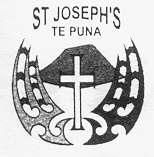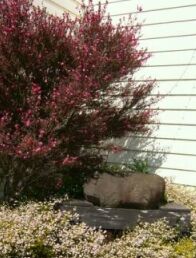 St Joseph’s Church was officially opened on
the 1st day of January 1900. The driving force behind the construction was
Werahiko Borell and Hone Bidois, both sons of French settlers who had
married into local Pirirakau families. These two men, with help from the
local people, worked for months from early morning to late at night
selecting, felling and pit-sawing the trees for transport down the river
and into the harbour and finally to the site of the Church. The first post
was put in place with an appropriate ceremony on the lst of November
1898.
St Joseph’s Church was officially opened on
the 1st day of January 1900. The driving force behind the construction was
Werahiko Borell and Hone Bidois, both sons of French settlers who had
married into local Pirirakau families. These two men, with help from the
local people, worked for months from early morning to late at night
selecting, felling and pit-sawing the trees for transport down the river
and into the harbour and finally to the site of the Church. The first post
was put in place with an appropriate ceremony on the lst of November
1898.
The Church has always been kept in good repair; however, in 1992, in
preparation for the Centennial of the Church opening, work was begun on
major renovations which included a new roof and repairs to the steeple.
Since then, the ongoing campaign to celebrate the Church's "big birthday"
culminated in the alterations to the Sanctuary, including the new carvings
and tukutuku panels. The panels have been part of a community effort
beginning with the selection and harvesting of the kiekie (flax) from the
bush, through the preparation and dying of the kiekie to the actual work
of weaving the flax onto the panels. The panels themselves were prepared
by Mr Bill Borell, a direct descendant of Werahiko. The repairs and
alterations to the Church have been carried out under the direction of Mr
Borell who has spent many hours on the project.
 On January lst 2000 a hikoi (walk) was held from the Whakamarama
bush site where Werahiko Borell and Hone Bidois had laboured, to St
Joseph's Churcb 17 kilometres away. As is traditional, prayers were said
at daybreak and the hikoi arrived at Te Puna at midday. Flags from the
Pirirakau, Aotearoa NZ, France, the Mill Hill Society and the Society of
Mary, were carried during that walk to honour the ancestors connected with
the years of the Church's history. Celebrations carried on throughout the
day.
On January lst 2000 a hikoi (walk) was held from the Whakamarama
bush site where Werahiko Borell and Hone Bidois had laboured, to St
Joseph's Churcb 17 kilometres away. As is traditional, prayers were said
at daybreak and the hikoi arrived at Te Puna at midday. Flags from the
Pirirakau, Aotearoa NZ, France, the Mill Hill Society and the Society of
Mary, were carried during that walk to honour the ancestors connected with
the years of the Church's history. Celebrations carried on throughout the
day.
The Church bell has had a chequered history. It was a gift from Bishop
Pompallier for the original Catholic Church at Otumoetai in Tauranga.
After Maori left Otumoetai, due to the confiscation of their land, the
Church fell into disrepair and the bell was re-located at St Mary's in
Tauranga. This caused considerable argument as the congregation at St
Mary's were mainly Pakeha, whilst the Te Puna congregation were mainly
Maori who regarded the bell as their property - it had called their people
to Mass in the early days of their conversion to the faith. They now
wished to install it in their new Church. Matters became so heated that
Father Holierhoek from St Joseph's and Father Broomfield from St Mary's
resorted to a physical struggle! After that, St Mary's kept the bell until
1920 when a party made a raid upon the belfry of St Mary's and removed the
prized bell to St Joseph's where it remains to this day.
 The Baptismal stone that stands at the right hand side of the
step leading to the Church is an historic stone, which was also used in
the original Church at Otumoetai. The Matheson family whose property is on
the site of the original Church, looked after the stone for many years. It
is through the generosity of this family that the stone was returned to
the Pirirakau people in 1992, along with some of the original carvings,
which are now in storage.
The Baptismal stone that stands at the right hand side of the
step leading to the Church is an historic stone, which was also used in
the original Church at Otumoetai. The Matheson family whose property is on
the site of the original Church, looked after the stone for many years. It
is through the generosity of this family that the stone was returned to
the Pirirakau people in 1992, along with some of the original carvings,
which are now in storage.
Stations of the Cross - These came from a church in Holland in Fr
Dolphyn's time. They are also over one hundred years old. Behind the
thirteenth station is the account of the loss of a baby at the Hui Aranga
in the centenary year of the church. The picture was the focus of the Good
Friday ceremonies and was in the chapel when the family had the final
prayers before the sad journey, to take baby back to the ancestral
homeland in the North.
Window - The Crucified, Risen Christ over Tauranga Moana
The window
is the work of John and Trish McReady of Waikino. Jack Holly was the
mastermind in the construction of the frame to carry the glass and the
mounting in the feature window.
The design and carving of the main poles (pou) was done by Simon
Madgewick. His assistants were James Tapiata, Rawiri Kuka, Motu from
Tuapiro and Aranga from Otawhiwhi. Simon also designed the spiral work
(kowhaiwhai) which was completed by Peter Nicholas, and designed the
weaving work (tukutuku) which was completed by the many helpers of the
families of the area.
Bill Borell, grandson of the original builder, did the carpentry for
the reconstruction of the sanctuary. The vertical heart rimu come from the
families of Ngati Han~arau. The totara for the sanctuary carvings came
from Tawhiti a Maru Marae, Wairoa, northern Hawkes Bay. Representatives of
the Marae were present for the rededication.